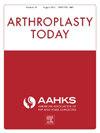Comparison of the Unipolar Electrocautery and the Bipolar Sealer in Reducing Blood Loss in Total Knee Arthroplasty: A Prospective, Randomized, Noninferiority Study
IF 1.5
Q3 ORTHOPEDICS
引用次数: 0
Abstract
Background
This was a noninferiority trial to evaluate blood loss during total knee arthroplasty (TKA) when using the unipolar electrocautery system compared to the saline coupled bipolar sealer system in primary TKA.
Methods
One hundred sixty-four patients were randomly assigned by a 1:1 ratio to either the unipolar electrocautery system (N = 82) or bipolar sealer system (N = 82). Inclusion criteria included patients scheduled for primary unilateral TKA, preoperative hemoglobin ≥11 mg/dL, preoperative platelet count ≥150,000, age >18 years, and patient willing to complete all study-related procedures. The primary efficacy outcome was estimated blood loss on morning of postoperative day. Secondary efficacy outcomes were comparison between the preoperative hemoglobin and postoperative day 1 hemoglobin, and allogeneic blood transfusions. Additionally, the study collected objective and functional outcomes using the postoperative 2011 Knee Society Score.
Results
The unipolar electrocautery system was not found to be less efficacious than the bipolar sealer system. Mean blood loss for the unipolar electrocautery system was 1062.0 cubic centimeters (cc) (95% confidence limit for the mean: 985.2, 1138.7), and for the bipolar sealer system was 929.4 cc (95% confidence limit for the mean: 841.9, 1016.8). The mean difference in blood loss was 132.6 cc, below the margin of inferiority set at 200 cc. Additionally, there was no difference in patient outcomes as measured by the Knee Society Score.
Conclusions
The safety, efficacy, and outcomes profile of the unipolar electrocautery system compared to the bipolar sealer system were similar. Use of the bipolar sealer system significantly increases surgical cost without any added benefits.
单极电烧与双极封口器在减少全膝关节置换术失血量方面的比较:前瞻性、随机、非劣效性研究
背景这是一项非劣效性试验,目的是评估在全膝关节置换术(TKA)中使用单极电烧系统与生理盐水耦合双极封片系统相比的失血量。纳入标准包括计划接受单侧 TKA 手术的患者、术前血红蛋白≥11 mg/dL、术前血小板计数≥150,000、年龄 18 岁、愿意完成所有与研究相关的手术。主要疗效指标是术后第二天早上的估计失血量。次要疗效指标是术前血红蛋白与术后第 1 天血红蛋白的比较,以及异体输血。此外,该研究还使用术后 2011 年膝关节协会评分收集了客观和功能性结果。结果未发现单极电烧系统的疗效低于双极封口系统。单极电烧系统的平均失血量为1062.0立方厘米(95%置信区间:985.2, 1138.7),双极封闭系统的平均失血量为929.4立方厘米(95%置信区间:841.9, 1016.8)。失血量的平均差异为 132.6 毫升,低于设定的 200 毫升的劣评值。结论 单极电烧系统与双极封孔器系统相比,安全性、有效性和结果均相似。使用双极封片系统会显著增加手术成本,却没有任何额外的益处。
本文章由计算机程序翻译,如有差异,请以英文原文为准。
求助全文
约1分钟内获得全文
求助全文
来源期刊

Arthroplasty Today
Medicine-Surgery
CiteScore
2.90
自引率
0.00%
发文量
258
审稿时长
40 weeks
期刊介绍:
Arthroplasty Today is a companion journal to the Journal of Arthroplasty. The journal Arthroplasty Today brings together the clinical and scientific foundations for joint replacement of the hip and knee in an open-access, online format. Arthroplasty Today solicits manuscripts of the highest quality from all areas of scientific endeavor that relate to joint replacement or the treatment of its complications, including those dealing with patient outcomes, economic and policy issues, prosthetic design, biomechanics, biomaterials, and biologic response to arthroplasty. The journal focuses on case reports. It is the purpose of Arthroplasty Today to present material to practicing orthopaedic surgeons that will keep them abreast of developments in the field, prove useful in the care of patients, and aid in understanding the scientific foundation of this subspecialty area of joint replacement. The international members of the Editorial Board provide a worldwide perspective for the journal''s area of interest. Their participation ensures that each issue of Arthroplasty Today provides the reader with timely, peer-reviewed articles of the highest quality.
 求助内容:
求助内容: 应助结果提醒方式:
应助结果提醒方式:


